GigaSMART Diameter S6a Correlation
Required Licenses: Diameter correlation license is available as a Base (100,000 users) and Max license (maximum number of users).
Diameter is an application layer protocol used in the GTP Mobile Infrastructure for authentication, authorization and accounting. The Diameter protocol uses SCTP protocol (and also TCP protocol). Thousands of diameter transactions occur every second on a relatively low network segment. Therefore, it is important to load balance the diameter transactions to the diameter processing probes (that have a finite capacity).
The GigaSMART Diameter Correlation application load balances the Diameter traffic to the LTE sessions of each of the subscriber such that the probes receive the S6a traffic for the given IMSI/MSISDN.
The application performs the following functions:
|
•
|
Correlates Diameter S6a message |
|
•
|
Provides support for FlowVUE functionality with Stateful Load balancing (based on IMSI/MSISDN) |
|
•
|
Provides single engine support and allows engine grouping, as well |
Diameter Correlation Engine
The Diameter Correlation Engine correlates the messages exchanged during the initial attach of the subscriber (except the reset messages). Each message has a mandatory field called Session-ID and User Name, and these fields are used to correlate the messages for a given subscriber.
When a message containing Diameter traffic is received, the Diameter correlation engine looks up the session in the session table for load balancing ports and sampling maps or whitelist map.
Note: The GigaSMART Diameter Correlation application uses dynamic memory instead of fixed memory. It can run with GTP and other compatible applications.
Diameter Whitelisting in a Cluster
The Diameter whitelist contains user names (IMSI) and command codes. Whitelist entries can only be numeric. For each entry, you can specify up to 14 to 15 numeric characters.
You can manually add one entry at a time to a whitelist file, or you can upload files in.txt format. Each whitelist file can have up to 20,000 entries. One or more whitelist files can be fetched from a local directory or remote URL using HTTP or SCP.
On GigaVUE-HC1, GigaVUE-HC2 and GigaVUE HD Series nodes, the whitelist database supports 500,000 entries. On GigaVUE-HC3 nodes, the whitelist database supports 1 million entries.
The GigaSMART operation does not have any rules for whitelisting.
Diameter Flow Sampling
FlowVUE is used for session-aware (stateful) load balancing and whitelisting with sampling.
Up to 10 flow sample maps per GigaSMART group are supported. Each flowsample map can have 20 rules. Use rules to filter based on User Name. The rules support numbers and wild card entries, up to 15 characters.
Sampling is based on User Name field.
Configuring Diameter S6a Correlation
To access GigaSMART within GigaVUE-FM, access a device that has been added to GigaVUE-FM from the GigaVUE-FM interface. GigaSMART appears in the navigation pane of the device view on supported devices. Refer to Access GigaSMART from GigaVUE-FM for details.
The following table summarizes the tasks required for configuring GigaSMART Diameter S6a :
Configuring GigaSMART Group
To configure a GigaSMART group and associate it with a GigaSMART engine port do the following.
|
1.
|
From the device view, select GigaSMART > GigaSMART Groups. |
|
2.
|
Click New. Configure a GigaSMART group and associate it with a GigaSMART engine port do the following. |
|
3.
|
Type an alias in the Alias field and enter an engine port in the Port List field. |

Figure 797: GigaSMART Group Port Info
|
4.
|
Scroll drown the page to select Diameter S6a Session parameters. |
|
•
|
Session Timeout (seconds) |
|
•
|
Diameter Packet Timeout (seconds) |
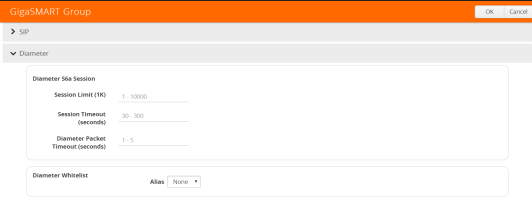
Figure 798: Diameter Port Parameters.
Creating Virtual Ports
To access GigaSMART within GigaVUE-FM, access a device that has been added to GigaVUE-FM from the GigaVUE-FM interface. GigaSMART appears in the navigation pane of the device view on supported devices. Refer to Access GigaSMART from GigaVUE-FM for details.
To create virtual ports, do the following:
|
1.
|
From the device view, select GigaSMART > Virtual Ports. |

Figure 799: Virtual Ports
|
3.
|
Enter an alias in the Alias field to identify the virtual port. |
|
4.
|
In the GigaSMART Groups field, select the GigaSMART Group configured in Step 1: of Configure a GigaSMART Group. |
Configuring GigaSMART Operation: Diameter Flow Sampling
Define a GigaSMART operation to enable Diameter Flow Sampling. If combining Flow Sampling with Load Balancing GSOPs, make sure that you select both operations when creating the GigaSMART Operation.
To access GigaSMART within GigaVUE-FM, access a device that has been added to GigaVUE-FM from the GigaVUE-FM interface. GigaSMART appears in the navigation pane of the device view on supported devices. Refer to Access GigaSMART from GigaVUE-FM for details.
To configure the GigaSMART Operation, do the following:
|
1.
|
From the device view, select GigaSMART > GigaSMART Operations (GSOP). |
|
2.
|
Click New. On the GigaSMART Operations page, do the following: |
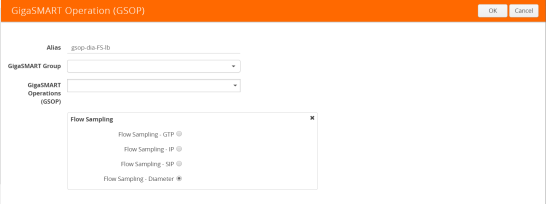
Figure 800: GigaSMART Operations page
|
3.
|
In the Alias field, enter an alias to help identify this GSOP. |
|
4.
|
In the GigaSMART Groups field, select the GigaSMART group configured in Step 1: Configure a GigaSMART Group. |
|
5.
|
In the GigaSMART Operations (GSOP) field, select Flow Sampling - Diameter. |
|
6.
|
Using the GSOP drop down list, select Load Balancing as the next GSOP operation. |
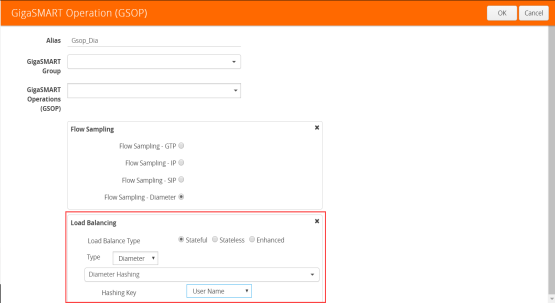
Figure 801: GigaSMART Operations - Load Balancing
Options:
- Stateful
- Stateless
- Enhanced
Note: Only Stateful load balancing option is supported for Diameter S6a Correlation.
|
8.
|
For Type, select Diameter as the stateful application within a group of GigaSMART operations. |
|
9.
|
Select Diameter Hashing as the Load Balancing Method. |
|
10.
|
Select the required Hashing Key. Options are: |
Create a first level map.
|
1.
|
Select Maps > Maps > Maps. |
|
3.
|
Type map-level1 in the Alias field. |
|
4.
|
Select First Level for Type and By Rule for Subtype. |
|
5.
|
Select port 1/1/x1 for the Source. |
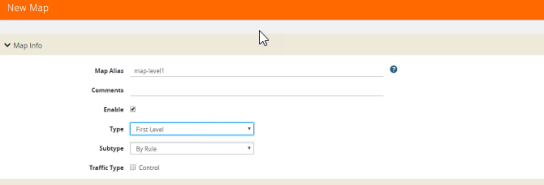
Figure 802: Create New Map
|
6.
|
Select virtual port vport1 for the Destination. |
|
7.
|
Click Add a Rule to add Rule 1 |
Create a second level map for Diameter Flow Sampling.
|
1.
|
Select Maps > Maps > Maps. |
|
3.
|
Type an alias in the Alias field. |
|
4.
|
Select Second Level for Type and Flow Sample Diameter for Subtype. |
|
5.
|
Select virtual port vport1 for the Source. |
|
6.
|
Select port group for the Destination. |
|
7.
|
Select from the GSOP list. |
|
9.
|
Select Diameter for the condition. |
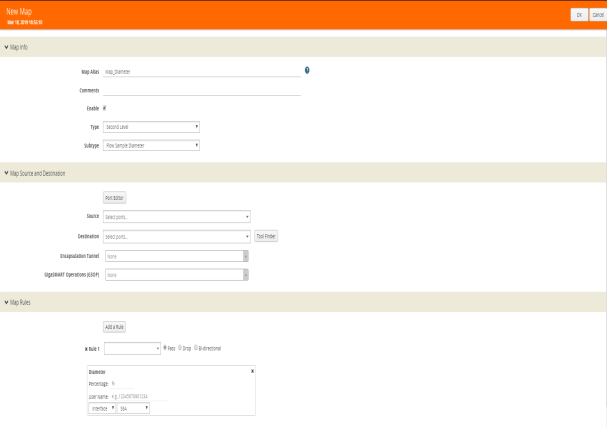
Figure 803: Create Second Level Map
|
10.
|
Enter the following details: |
|
•
|
Percentage for the amount of traffic you want to be affected by Diameter flow sampling |
Configuring GigaSMART Operation: Diameter Whitelisting
|
1.
|
From the device view, select GigaSMART > Whitelist. |
|
3.
|
Type an alias in the Alias field. |
|
4.
|
Select the Whitelist type as Diameter. |
|
5.
|
You can either upload the details manually (you must enter the Diameter Entry) or load whitelist files from a specified location to populate the Diameter whitelist. You can either: |
|
•
|
Upload from URL: Enter the URL in the Remote URL field and the Password required to access the URL. |
|
•
|
Upload a File: Choose the location of the file name |
Associating the GigaSMART group to the Diameter whitelist
|
1.
|
From the device view, select GigaSMART > GigaSMART Groups > GigaSMART Groups. |
|
2.
|
Select the GigaSMART Group you previously created and click Edit. |
|
3.
|
Under Diameter Whitelist, select the alias previously created from the available list. |
Configuring GigaSMART operation for Diameter whitelisting
|
1.
|
From the device view, select GigaSMART > GigaSMART Operations > GigaSMART Operation. |
|
3.
|
Type an alias in the Alias field. |
|
4.
|
Select the GigaSMART group created in task 1. |
|
5.
|
From the GigaSMART Operations (GSOP) drop-down list, select the following: |
|
•
|
Whitelist and select Diameter. |
|
6.
|
For Load Balancing, do the following: |
|
b.
|
For Type select: Diameter |
|
c.
|
Select Diameter Hashing and enter the following Hashing Key parameters: |
7. Click OK.
Configure first level map
|
1.
|
Select Maps > Maps > Maps. |
|
b.
|
Type: First Level, Sub Type: By Rule |
Create another second level map for Diameter flow whitelist
|
1.
|
Select Maps > Maps > Maps. |
|
b.
|
Type: Second Level, Sub Type: Flow Whitelist Diameter |
|
d.
|
Destination: Port group |
|
e.
|
Select from the GSOP list. |
Displaying Diameter Reports
To display Diameter report, do the following:
|
1.
|
From the device view, select GigaSMART> GigaSMART Groups> Report. |
|
2.
|
Select Group Type: Flow Diameter S6a. |
|
3.
|
Select the required GigaSMART Groups: gsg1 |
|
4.
|
Specify the User Name Pattern. |
|
5.
|
Select Any. This returns any pattern. |

Figure 804: Generate Diameter Report
|
6.
|
Click the Generate button. The Diameter Messages Report is displayed. |

Figure 805: Diameter Report Page












